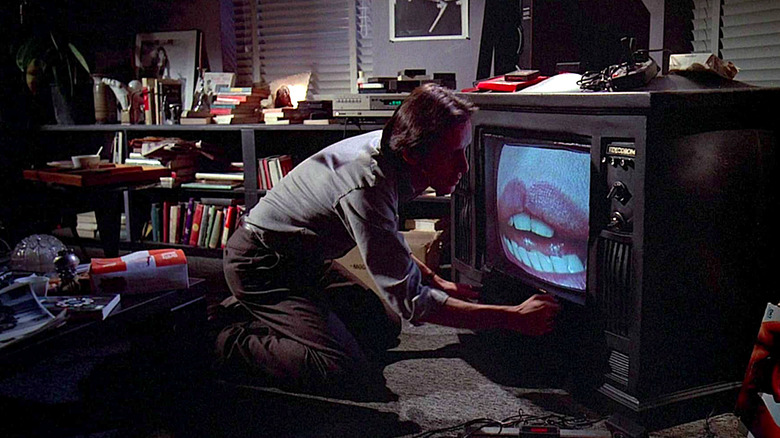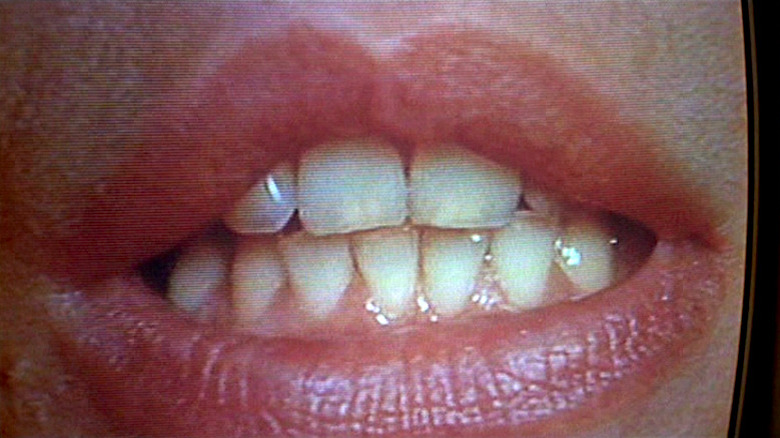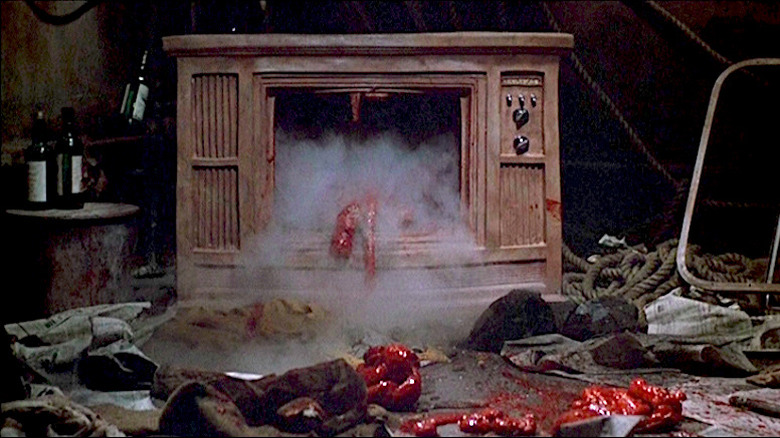How Videodrome's Special Effects Team Pulled Off The Breathing Screen
The most terrifying part of owning my computer is that every week it gives me an update on how much screen time I've averaged over the last seven days. Like most of us, I spend a lot of time online, so I expect my average number of hours to be fairly high. One week, though, the notification read, "You have averaged 24 hours of screen time per day!" I have never felt more terrified. Not only could I not recall if I had been spending an above-average amount of time at my computer, but I also could not definitively say that number was wrong. My brain and my screen had melded into one, and I was completely powerless to recognize the difference.
Director and body horror master David Cronenberg knew something was up with our dependence on screen time all the way back in 1983 when he released his television-obsessed film, "Videodrome" (ironically, the movie came out the same year that the internet is largely considered to have "been born"). This bizarre, often-erotic film delves into society's dependence on television and media by following the story of Max Renn, the head of a large TV station who happens to discover a violent yet enticing sort of snuff film airing on an unknown channel. In his attempt to uncover the true source of this material, Renn falls deeper and deeper into the dark world of television and media, distorting his life along the way.
The movie is fantastic for many reasons, but some of the most memorable moments are found in its practical effects. The scene where Renn all but makes love to a gyrating, breathing television has particular staying power. Often, we lose sight of the materialism of the screen in front of us, mistaking pixels for people, and Renn's hallucination of the living television becomes even more powerful when you take into account how they managed to pull off such a visually strange scene.
A new flesh for a new type of TV screen
The scene in question involves an old TeleRANGER television. Chosen for its bulk, it dominates the scene as a huge, hulking object that is entirely impossible to ignore. After deciding to play a Betamax tape given to him by his secretary, Max Renn begins to hallucinate, imagining the television coming to life. Projected on the screen is an image of his lover Nicki. She sensually coaxes Renn to come closer to the television, and as she does so, the camera zooms in on just her mouth until it is the only thing filling the screen. As the television seduces Renn, it quite literally begins to breathe. The top of the television expands and contracts, getting veiny (ew) each time Renn touches it, and eventually the screen itself bulges outward and Renn shoves his entire head inside Nicki's projected mouth. Talk about symbolism.
Making this scene happen was not easy, but because Rick Baker — the special effects guru behind "An American Werewolf in London" and its killer transformation scene — was at the helm of this project, the challenge of the breathing television was not beyond reach. In an article for The Criterion Channel, Baker explains how they managed to make a moveable screen using, somewhat ironically, dental dam material. The material was coated in white paint and stretched and responded to touch in all the right ways. The footage of Nicki speaking was projected onto the material from the opposite side of the screen so that when the screen billowed, the image billowed effortlessly along with it giving the viewers the pulsating quality of Nicki's lips.
And just how DID they get it to billow?
Of course, this scene would not be as memorable as it is if the screen didn't actually move. So in order to get it to swell and pulsate convincingly, the television had to be affixed with a series of bellows that blew air into different areas depending on what needed to inflate. An article for Film School Rejects (quoting a video interview with Cronenberg and filmmaker Mick Garris) explains how a keyboard organ and a valved air compressor were rigged to get airflow to occur simply with the push of a key. This allowed the special effects team to control the various moving parts of the television in whatever order they chose. So in other words, they came up with a way to push all the right buttons on this erotic TV. Ha ... aha ... ha ...
The result of both the screen itself and the use of airflow to inflate and deflate parts of the TV set at will is a creepily sensual scene that is, dare I say, even a little bit sexy? Funnily enough, James Woods, the actor who played Max Renn in the film, doesn't necessarily think so. He told Criterion that he "felt sort of stupid when [he] was doing it," leaving us all to gasp in amazement. I mean, sure. Maybe tenderly caressing a salacious television set as it eerily expands and contracts in response to your touch isn't exactly the most normal thing to be doing on film, but Woods sure convinced all of us of the television and the Betamax tape's powerful hold on Renn's mind, a technological grip that still exists to this day. Long live the new flesh.


